All electronics projects need power. Power can come from either stored energy in a battery, or directly from mains AC voltage or DC power from renewable sources such as solar energy. Power Management ICs (PMICs) help manage the power requirements in a system including scaling voltages, battery charging, and DC-DC conversion. Choosing the right PMIC can make a difference in whether the final product becomes successful or not. An integral part of any PMIC solution is a voltage regulator. Voltage regulators provide a constant output voltage from a higher or lower input voltage. In this blog, let’s look at the variety of voltage regulators, how to choose them, and how Octopart data can help you make the decision to choose the right voltage regulator for your project. This is a follow-up on our series of blogs on how to select a capacitor, resistor, inductor, connector, IC packages and MCUs.
Voltage Regulators
Voltage regulators provide a stable DC voltage during operation of a system. Voltage regulators can receive power from either mains AC voltage from wall outlets or from batteries in electronic devices. Batteries discharge almost linearly with time and voltage regulators are needed to maintain stable power supply for electronic systems. This can be seen below:
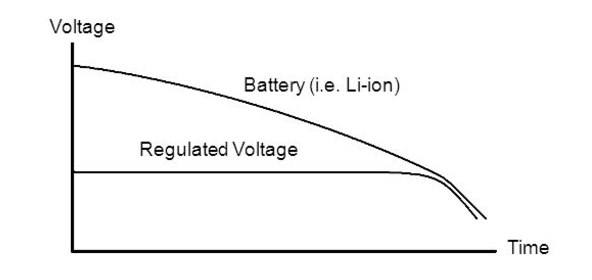
Batteries discharge with time -- voltage regulation is required
In addition to powering circuits, a precise DC voltage is often used as a reference to which voltage signals are compared to make decisions. If this reference voltage is not very stable and fluctuates a lot, it affects the decision making of a system. NOTE: Input voltage and supply voltage are sometimes used interchangeably, as voltage regulators use supply voltage as their input.
Let’s dive into some of the most common parameters that are used to choose a voltage regulator. We’ll take Texas Instruments’ TPS76733 as an example to learn about the parameters that drive the decision to choose a particular regulator.
IMPORTANT PARAMETERS:
- Output voltage: Output voltage is the constant voltage that you expect the voltage regulator to regulate voltage at. A regulator takes a noisy input and regulates it to a particular voltage, for example, 3.3V.
- Accuracy: Accuracy refers to how much the output voltage changes across temperature and load current.
- Load current: Load current refers to the maximum output current expected from the voltage regulator by the load system.
- Efficiency: The efficiency of a regulator is given by a ratio of output power to input power which is proportional to the ratio of output voltage to input voltage. Dropout voltage of a regulator limits how close the output can be to the input. The lower the dropout voltage, the more efficient the linear regulator will be. Switching regulators have a theoretical hundred percent efficiency, but is in practice limited by the resistance of FET switch, diode voltage drop and ESR of both inductor and output capacitor.
- Dropout voltage: Dropout voltage is only applicable for linear regulators. It is the smallest possible difference between output and input supply voltage while remaining in the intended operating range of the voltage regulator. For TPS76733, the dropout voltage is 350 mV. For getting the correct output of 3.3V, input voltage has to be at least 3.65V as can be seen below:
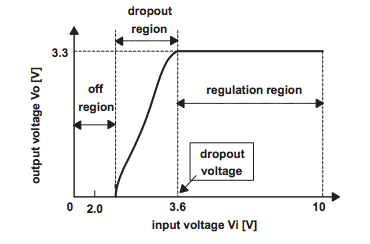 Dropout region of a 3.3V voltage regulator
Dropout region of a 3.3V voltage regulator - Power Supply Rejection Ratio: Power Supply Rejection Ratio or PSRR refers to the ratio of change in output voltage to change in input supply voltage. For example, if there is a 1mV ripple in power supply at 1kHz and it translates to output ripple of 1uV, the PSRR is 60dB at 1kHz. As you can see below, higher frequencies have lower PSRR, and thus have a greater chance of getting coupled into the output.
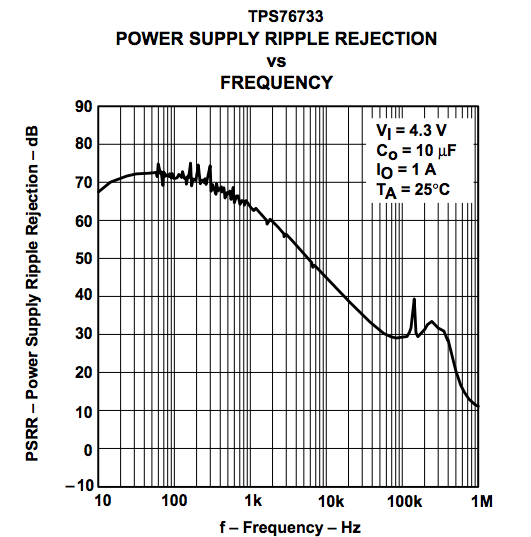 Higher frequency supply ripple impacts output more due to lower PSRR
Higher frequency supply ripple impacts output more due to lower PSRR - Line regulation: Line regulation is PSRR at DC or zero frequency. It means that if there is a 1V offset at power supply and if output voltage changes by 1mV, you get a line regulation of 1mV/V. In the plot of dropout region above, it’d be the slope of the output voltage to input voltage in the regulation region.
- Load regulation: Load regulation refers to how much output voltage changes with change in load current. So if load current has a big jump from 1mA to 101 mA, and it changes the output voltage by 10 mV, load regulation will be 0.1mV/mA.
- Transient Response: When output current changes quickly, the voltage regulator takes time before it can settle back to the expected output voltage. There can be “spikes” at the output. This can be seen using an oscilloscope. You can see a load transient response below:
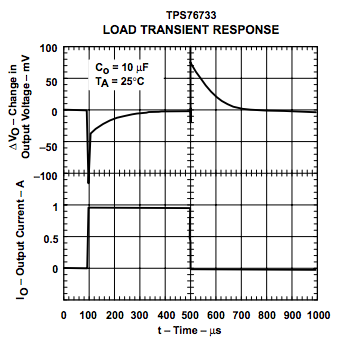 Output voltage showing spikes of 100mV when load current switches
Output voltage showing spikes of 100mV when load current switches
Get more info by reading this excellent manual on the parameters above.
TYPES
There are two main types of voltage regulators. The first type is linear voltage regulators. Linear voltage regulators step down the voltage using impedance control at the output. The second type is switching voltage regulators or DC-DC converters. Switching voltage regulators can step up or step down the voltage depending on architecture and they achieve so by using on/off switching operations. Linear regulators are usually less efficient but cheaper, on the other hand, switching regulators are more efficient but are much more expensive.
I. Linear Voltage Regulator:
Linear voltage regulators are used to step down a high input voltage to a steady voltage at the output. Linear regulators achieve this by changing the impedance at the output according to load current, resulting in constant output voltage. A typical linear voltage regulator is shown below. When the dropout voltage is low, it is called a low dropout regulator or LDO. LDOs have PMOS or PNP BJT as their Pass FET. Cout is a minimum capacitor at the output pin to ensure stability.
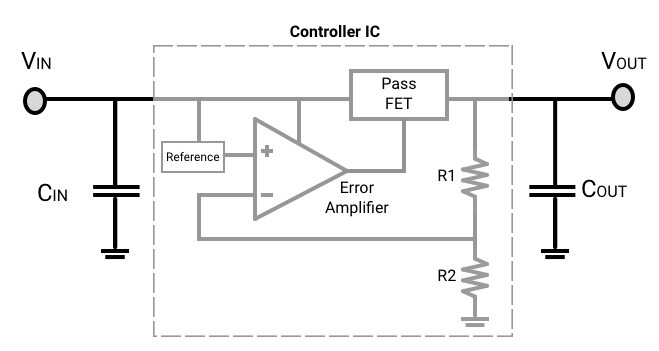
Inside the IC of a linear voltage regulator
When to use linear voltage regulators?
- Very low noise applications: Switching regulators have higher noise as they have switching operations. Linear regulators, on the other hand, do not use switching operations, so they have much lower noise at output. One common approach is to use a switching regulator cascaded by a low dropout regulator or LDOs to get lowest possible noise.
- Very low power applications: It will depend from case to case, but linear regulators can be designed with less than 100uA quiescent current, but switching regulators usually require complex current/voltage feedback control circuits which need more quiescent power.
- When output voltage is close to input voltage: Linear regulators when configured as LDOs can have very high efficiency when output voltage is very close to input voltage as it is proportional to output voltage by input voltage.
- Low cost applications: Linear regulators are easy to use and just need a maximum of one external capacitor. Switching regulators, on the other hand, need an inductor, capacitor and a Schottky diode. To put it in perspective: LD1117 only costs ~$0.50 but a switching voltage regulator IC like LMR12010 can cost ~$7 to assemble and use.
Part Selection: Surface Mount: STMicroelectronics’ LD1117 series [CPL] Texas Instrument’s LP2985 series [CPL] Through-Hole: ON Semiconductor’s LM317 series [CPL]
II. Switching Voltage Regulator:
Switching regulators or DC-DC converters are used universally in almost all electronic devices. They are popular as they have high efficiency during both step up (boost converter) and step down (buck converter) of DC voltage. Below is a simplified diagram of a buck converter which is used to step down DC voltage. A controller IC is required to sense the feedback voltage and adjust the switching PWM accordingly. Some DC-DC converters today replace the diode with a transistor for synchronous rectification for higher efficiency. This efficiency comes at a higher cost as a more complex driver is needed.
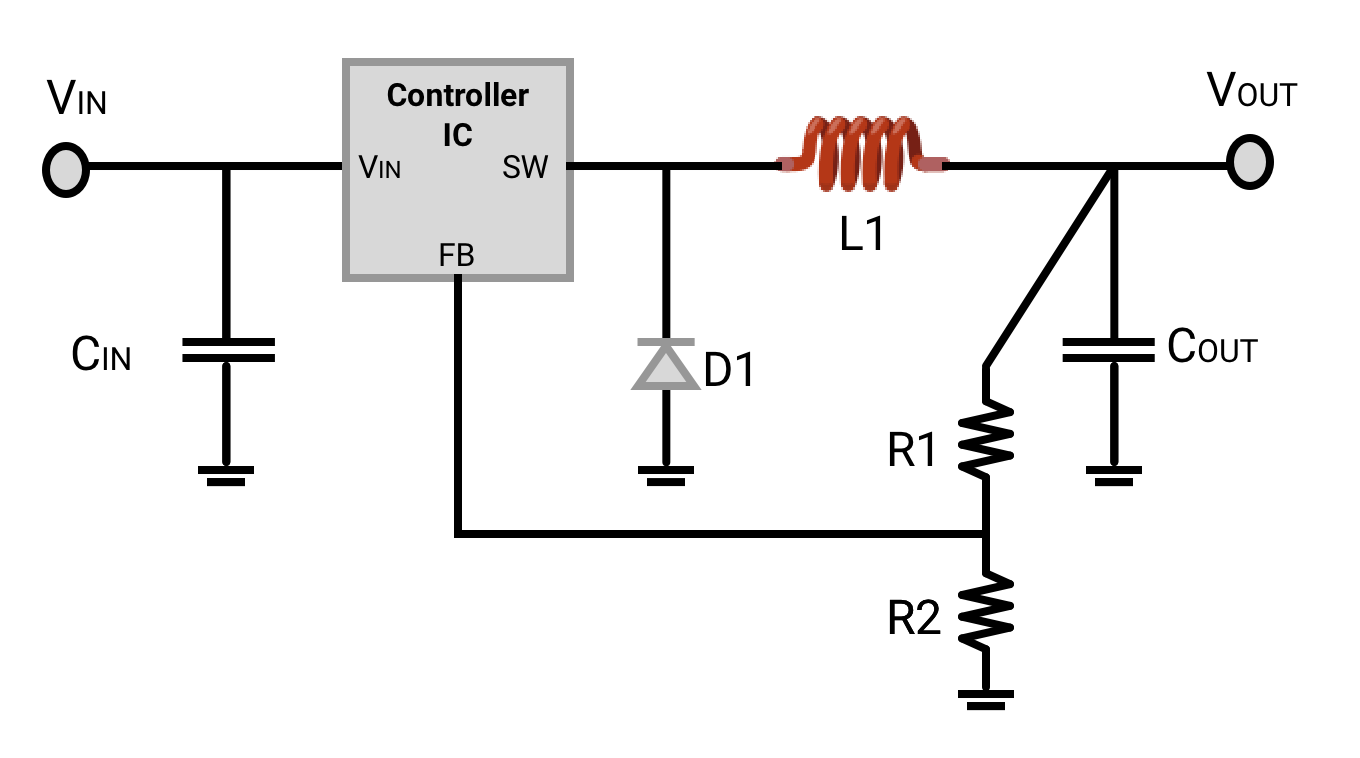
Schematic of a buck converter
When to use switching voltage regulators?
- High efficiency applications: Switching regulators turn on and off, so they are able to be more efficient. They can achieve even 90% efficiency which is hard to reach for linear regulators unless they are configured as LDOs.
- When DC output voltage needs to be higher than input voltage: With boost or buck-boost configurations, switching regulators allow DC output voltage to be more than the input voltage. This is particularly useful in cases when sudden large voltages are needed such as flash lights in a camera.
- When good thermal performance is needed: Linear regulators waste a lot of power which is dissipated as heat and usually need heat sinks. Switching voltage regulators don't need heat sinks. Also, as they are used with a control IC, you can get 'over temperature protection' which is usually missing in the linear regulator ICs.
Switching Controller vs Switching Regulator
You might see these two terms used in the context of switching regulators. Switching regulator ICs handle switching operations within the IC. As a result, they can’t handle a lot of current. With switching controllers, on the other hand, the switching function is done external to the IC which allows for much higher currents. Switching controllers have a lot more options for configuration, and are much more complex than switching regulators. In summary, if you need very high currents, use switching controllers as they use external switching FETs.
Part Selection:
Buck Converter: Texas Instruments’ LMR12010 series [CPL]
Boost Converter: Texas Instruments’ TLV6122 series
This guide covers some of the most popular types of voltage regulators including selecting them for different applications and the important parameters. If you have any comments or suggestions on the part selection, drop us a note in our Slack chat room or in comments below. Till next time.